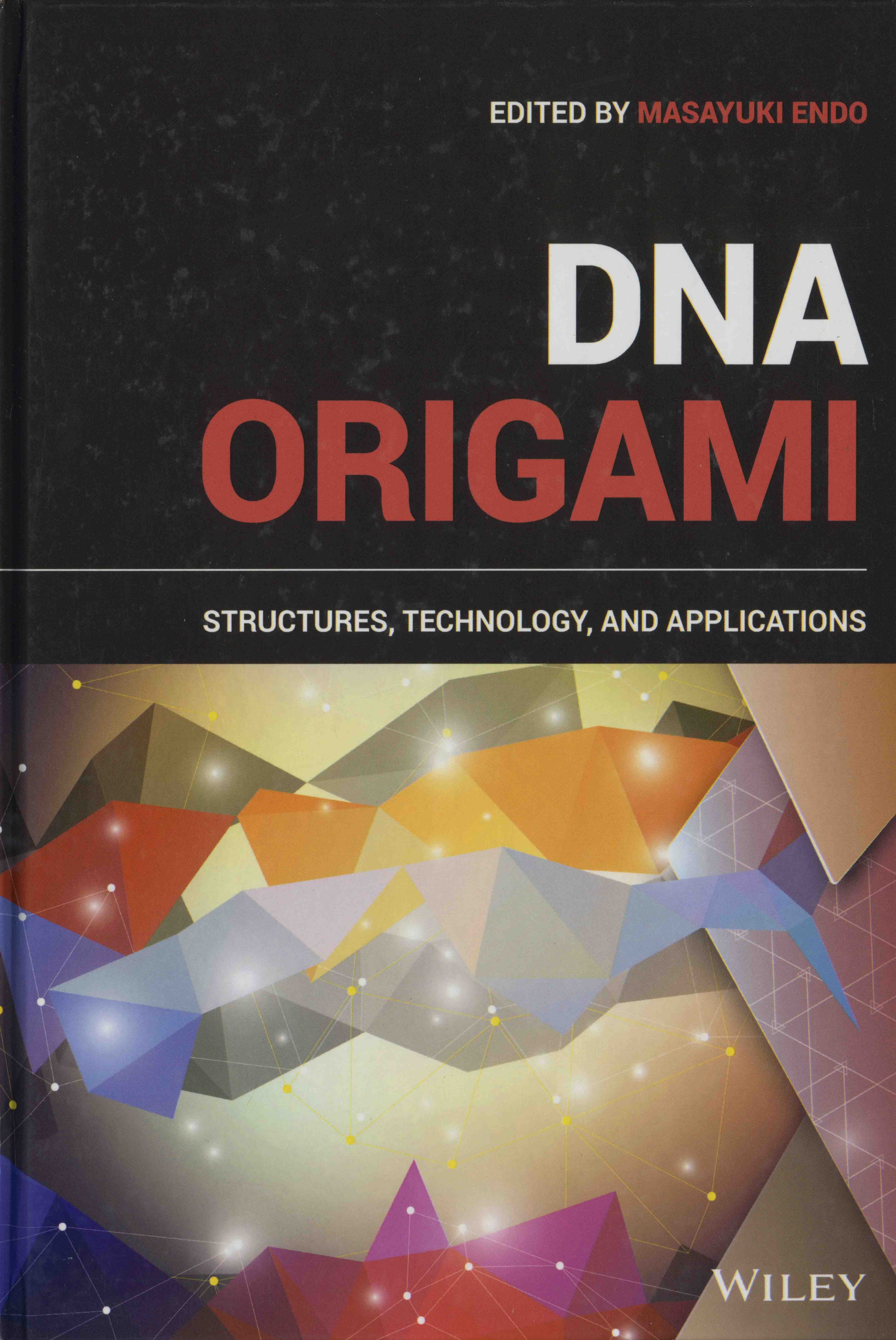 |
DNA origami : structures, technology and applications / edited by Masayuki Endo -- Hoboken, NJ : Wiley, 2022. – (58.174252/D629t) |
Contents
List of Contributors
Preface
1 DNA Origami Technology: Achievements in the Initial 10 Years
1.1 Introduction 1
1.2 Two-Dimensional DNA Origami 3
1.3 Programmed Arrangement of Multiple DNA Origami Components 6
1.4 Three-Dimensional DNA Origami Structures 9
1.5 Modification and Functionalization of 2D DNA Origami Structures 11
1.6 Single-Molecule Detection and Sensing using DNA Origami Structures 14
1.7 Application to Single Biomolecule AFM Imaging 16
1.8 Single-Molecule Fluorescence Studies 19
1.9 DNA Molecular Machines 22
1.10 Selective Incorporation of Nanomaterials and the Applications 24
1.11 Dynamic DNA Origami Structures Responsive to External Stimuli 27
1.12 Conjugation of DNA Origami to Lipid 29
1.13 DNA Origami for Biological Applications 29
1.14 Conclusions 33
References 34
2 Wireframe DNA Origami and Its Application as Toots for Molecular Force Generation
2.1 Introduction 41
2.2 Pre-Origami Wireframe DNA Nanostructures 42
2.3 Hierarchical DNA Origami Wireframe 43
2.4 Entire DNA Origami Design 45
2.5 DNA Origami Wireframe as Tools for Molecular Force Application 50
2.6 Conclusions 54
References 55
3 Capturing Structural Switching and Serf-Assembly Events Using High-Speed Atomic Force Microscopy 59
3.1 Introduction 59
3.2 DNA Origami Nanomachines 60
3.3 Ion-Responsive Mechanical DNA Origami Devices 60
3.4 Photoresponsive Devices 62
3.5 Two-Dimensional Self-Assembly Processes 64
3.6 Sequential Self-Assembly 66
3.7 Photostimulated Assembly and Disassembly 67
3.8 Conclusions and Perspectives 69
References 69
4 Advancement of Computer-Aided Design Software and Simulation Tools for Nucleic Acid Nanostructures and DNA Origami 75
4.1 Introduction 75
4.2 General-Purpose Software 76
4.3 Software for Designing Small DNA Nanostructures 78
4.4 Software for Designing DNA Origami 81
4.5 Software for Designing RNA Nanostructures 84
4.6 Software for Designing Base Sequence 84
4.7 Software for Simulating Nucleic Acid Nanostructures 85
4.8 Summary and Future Perspective 86
References 87
5 Dynamic and Mechanical Applications of DNA Nanostructures in Biophysics 101
5.1 Introduction 101
5.2 Applications 105
5.3 Tools for Quantifying DNA Devices and their Functions 120
5.4 Modeling and Analysis 123
5.5 Conclusion 124
References 124
6 Plasmonic Nanostructures Assembled by DNA Origami 135
6.1 Introduction 135
6.2 Optical Properties of the DNA Origami-Based Plasmonic Nanostructures 135
6.3 Nanoparticle Functionalization with DNA 138
6.4 DNA Origami-Based Plasmonic Assemblies 140
6.5 Surface-Enhanced Raman Scattering (SERS) and Other Plasmonic Effects 143
6.6 Conclusion 152
Acknowledgments 152
References 152
7 Assembly of Nanoparticle Superlattices Using DNA Origami as a Template 155
7.1 Introduction 155
7.2 Gold Nanoparticles 156
7.3 Formation of DNA Origami-Assisted Superlattices 158
7.4 Characterization of Assemblies 160
7.5 Conclusions and Future Perspectives 162
Acknowledgments 164
References 164
8 Mechanics of DNA Origami Nanoassemblies 167
8.1 Introduction 167
8.2 Analytical Tools to Investigate Mechanical Properties of Nanoassemblies
8.3 Mechanical Strength of DNA Origami Structures 171
8.4 Applications of Origami Nanostructures by Exploiting their Mechanical Strength 173
8.5 Mechanochemical Properties of DNA Origami 175
8.6 Conclusions 177
References 177
9 3D DNA Origami as Single-Molecule Biophysical Tools for Dissecting Molecular Motor Functions 181
9.1 Introduction 181
9.2 DNA Origami Nanospring 181
9.3 DNA Origami Thick Filament Mimicking Muscle Structure 187
9.4 Perspective 193
References 193
10 Switchable DNA Origami Nanostructures and Their Applications 197
10.1 Introduction 197
10.2 Switchable Machines Constructed from DNA Origami Scaffolds 198
10.3 DNA Origami Scaffolds for Defined Mechanical Operations 210
10.4 Switchable Interconnected 2D Origami Assemblies 218
10.5 Dynamic Triggered Switching of Origami for Controlled Release 223
10.6 Switchable Plasmonic Phenomena with DNA Origami Scaffolds 227
10.7 Origami-Guided Organization of Nanoparticles and Proteins 234
10.8 Conclusions and Perspectives 238
References 239
11 The Effect of DNA Boundaries on Enzymatic Reactions 241
11.1 Introduction 241
11.2 DNA-Scaffolded Single Enzymes 242
11.3 DNA-Scaffolded Enzyme Cascades 247
11.4 On the Proximity Model and Other Hypotheses 250
11.5 Conclusions 254
Acknowledgments 256
References 256
12 The Methods to Assemble Functional Proteins on DNA Scaffold and their Applications 261
12.1 Introduction 261
12.2 Overview of the Methods for Arranging Proteins on DNA Scaffolds 262
12.3 DNA-Binding Adaptor for Assembling Proteins on DNA Scaffold and its Application 270
12.4 Summary 278
References 278
13 DNA Origami for Synthetic Biology: An Integrated Gene Logic-Chip 281
13.1 Introduction 281
13.2 Biomolecule Integration on DNA Nanostructure 281
13.3 Gene Expression Control Using DNA Nanostructure 285
13.4 Summary and Perspective 292
Acknowledgments 293
References 293
14 DNA Origami for Molecular Robotics 297
14.1 DNA Origami as a Stage for DNA Walkers and Robotic Arms 297
14.2 Nanomechanical DNA Origami 298
14.3 DNA Origami Used in Combination with Molecular Motors 300
14.4 Future Perspective 301
References 303
15 DNA origami Nanotechnology for the Visualization, Analysis, and Control of Molecular Events with Nanoscale Precision 305
15.1 Introduction 305
15.2 Designing of DNA Origami Frames for the Direct Observation of DNA Conformational Changes 308
15.3 Direct Observation of DNA Structural Changes in the DNA Origami Frame 308
15.4 Direct Observation and Regulation of Enzyme Reactions in the DNA Origami Frame 315
15.5 Direct Observation of a Mobile DNA Nanomachine using DNA Origami 321
15.6 Limitations of AFM Imaging and Comparison with other Imaging Techniques 326
15.7 Conclusions and Perspectives 326
References 327
16 Stability and Stabilization of DNA Nanostructures in Biomedical Applications 333
16.1 Threats for DNA Nanostructures 333
16.2 Strategies to Protect DNA Origami Structures 349
References 362
17 DNA Nanostructures for Cancer Diagnosis and Therapy 379
17.1 Introduction 379
17.2 DNA Nanostructure-Based Diagnostics 380
17.3 DNA Nanostructure-Based Drug Delivery 386
17.4 Challenges and Prospects 394
References 400
Index 411